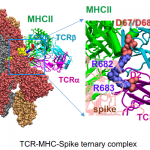An inflammatory disease similar to Kawasaki disease has been reported in children infected with SARS-CoV-2, and WHO has named the disease “Multisystem Infectious Syndrome in Children: MIS-C.”
The fact that the MIS-C shows clinical symptoms similar to toxic shock syndrome (TSS) hints at the presence of bacterial super antigens in SARS-CoV-2.
https://www.biorxiv.org/content/10.1101/2020.11.09.372169v1
In this report, it was confirmed that the severity of MIS-C and cytokine storms are strongly correlated with the expansion of T-cell Receptor Beta Variable gene (TRBV) 11-2. Molecular dynamics studies have also confirmed that a T-cell receptor (containing TRBV11-2) and MHCII form a complex strongly coupled with a bacterial super-antigen-like structure (region from E661 to R685 around the polybasic insert PRRA) presents in SARS-CoV-2 S-protein. This will activate a number of T-cells nonspecifically and release a large amount of cytokines.

